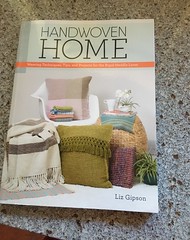Reading, Again!
First up! Last week's post garnered more than 2! comments, so I have turned to a random number generator. Thanks to everyone for commenting, and I truly do recommend this book if you have any inclination to buy it or put it on your gift list!
Between number 1 and 15 the generator picked...#1! Congratualtions jeekeehoo! You'll need to sned me an address: sara at sara lamb dot com (remove all spaces, etc., yadda yadda).
Further reading: I have cleared out some magazine subscriptions that no longer served me, and found a few new ones. Below are the ones I currently take. For fiber and serious weaving:

Selvedge, for inspiration, Vav for inspiration and weaving information, Fiber Art Now for aspiration, Piecework and SpinOff for tips, tricks, how-to's and news of my community.
Newer more self-published magazines, whose layout, content and graphic presence are clean, readable and inspiring:

Taproot, not a craft magazine per se, but has crafts, gardening/farming, herbs, and thoughtful essays, with a new compilation book of crafts and things to make from their first several years' of publication, KnitWit, and Making, both published by crafters/knitters, both with a clean look and some inspiring work.
and last, if you cook (who doesn't?) my new favorite foody mag:

The new project by Christopher Kimball, formerly Cook's Magazine and America's Test Kitchen, now out on his own with this eminently readable and eatable offering!
Most of these are also available at newsstands and good book stores, so you can check them out before subscribing. Or...order a single issue from their websites.
I depend on publications for news and inspiration, and (truth in advertising here) have had work published in some of these over the years. They are mostly daydream publications for me, rather than how-to: I am inspired by the work of others, and sometimes their solutions solve my problems. They are not too "thinky", and do not try too hard to intellectualize what is, for me, and visual and tactile world. Studio work can be lonely and isolated: the people between these pages help me feel connected to the people inhabiting this little corner of the fiber world.
Between number 1 and 15 the generator picked...#1! Congratualtions jeekeehoo! You'll need to sned me an address: sara at sara lamb dot com (remove all spaces, etc., yadda yadda).
Further reading: I have cleared out some magazine subscriptions that no longer served me, and found a few new ones. Below are the ones I currently take. For fiber and serious weaving:

Selvedge, for inspiration, Vav for inspiration and weaving information, Fiber Art Now for aspiration, Piecework and SpinOff for tips, tricks, how-to's and news of my community.
Newer more self-published magazines, whose layout, content and graphic presence are clean, readable and inspiring:

Taproot, not a craft magazine per se, but has crafts, gardening/farming, herbs, and thoughtful essays, with a new compilation book of crafts and things to make from their first several years' of publication, KnitWit, and Making, both published by crafters/knitters, both with a clean look and some inspiring work.
and last, if you cook (who doesn't?) my new favorite foody mag:

The new project by Christopher Kimball, formerly Cook's Magazine and America's Test Kitchen, now out on his own with this eminently readable and eatable offering!
Most of these are also available at newsstands and good book stores, so you can check them out before subscribing. Or...order a single issue from their websites.
I depend on publications for news and inspiration, and (truth in advertising here) have had work published in some of these over the years. They are mostly daydream publications for me, rather than how-to: I am inspired by the work of others, and sometimes their solutions solve my problems. They are not too "thinky", and do not try too hard to intellectualize what is, for me, and visual and tactile world. Studio work can be lonely and isolated: the people between these pages help me feel connected to the people inhabiting this little corner of the fiber world.

